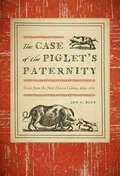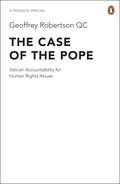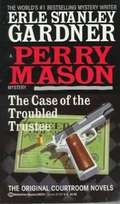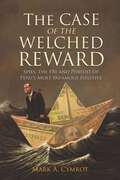- Table View
- List View
The Case of the Piglet's Paternity: Trials from the New Haven Colony, 1639–1663 (The Driftless Connecticut Series)
by Jon C. BlueA vivid series of trials from America’s earliest days
The Case of the Pope: Vatican Accountability for Human Rights Abuse
by Geoffrey Robertson QCTHE CASE OF THE POPE delivers a devastating indictment of the way the Vatican has run a secret legal system that shields paedophile priests from criminal trial around the world.Is the Pope morally or legally responsible for the negligence that has allowed so many terrible crimes to go unpunished? Should he and his seat of power, the Holy See, continue to enjoy an immunity that places them above the law?Geoffrey Robertson QC, a distinguished human rights lawyer and judge, evinces a deep respect for the good works of Catholics and their church. But, he argues, unless Pope Benedict XVI can divest himself of the beguilements of statehood and devotion to obsolescent canon law, the Vatican will remain a serious enemy to the advance of human rights.
The Case of the Rolling Bones
by Erle Stanley GardnerPerry Mason is almost stumped by the case of the Klondike millionaire imprisoned in Seattle and wanted for murdering the same man in both Alaska and California.
The Case of the Runaway Corpse
by Erle Stanley GardnerPerry Mason defends a woman accused of poisoning her husband--even though witnesses saw the corpse climb out the motel window.
The Case of the Screaming Woman
by Erle Stanley GardnerA baby-peddling doctor is murdered, and Mason's client, John Kirby, is lying. The famous lawyer must discover the killer's identity before Hamilton Burger can crucify both Kirby and Mason's professional ethics in court. Suspects abound, from the screaming woman heard at the crime scene, to John Kirby, to the second woman seen fleeing out the back door ...
The Case of the Shapely Shadow
by Erle Stanley GardnerA secretary, convinced her boss is being blackmailed, hires Perry Mason to secure evidence. But when her boss is found murdered, she needs him to defend her on murder charges.
The Case of the Shoplifter's Shoe
by Erle Stanley GardnerAfter her well-to-do Aunt Sarah is caught shoplifting, Virginia Trent is convinced she needs to seek psychiatric help for kleptomania. So why does Virginia turn to legal eagle Perry Mason? Because a cache of valuable diamonds--left in Sarah's care--has suddenly vanished into thin air. Virginia thinks Sarah swiped the stones, but gem dealer Austin Cullens begs to differ. In fact, he's prepared to forgive and forget--until he is mysteriously murdered and Sarah is caught running from the crime scene. Now it appears the lady with the sticky fingers may have blood on her hands. ...
The Case of the Silent Partner
by Erle Stanley GardnerA dynamic young businesswoman is in danger of losing control of her flower shop, and someone sends poisoned bonbons to a nightclub hostess. Mason must reacquire some stock and defend the businesswoman. This novel is the first to feature Lt. Arthur Tragg.
The Case of the Singing Skirt
by Erle Stanley GardnerEllen Robb does more than just sing for her supper -- she also dances and sells cigarettes in a two-bit gambling parlor in a one-horse town. But when she hits a sour note with her scheming employer by refusing to help fleece a fat-cat customer in a crooked card game, she finds herself out of all three jobs. That's when she sings her song of woe to Perry Mason, who promises to turn her blues into greenbacks with the help of his crack team, Della Street and Paul Drake, and a hefty lawsuit. Things are humming along just fine -- until murder interrupts the merry melody of Mason's crafty legal maneuvers. When the vindictive wife of Ellen Robb's not-so-secret lover turns up shot to death, Mason is certain it's a frame-up -- and that his songbird client's belligerent boss is to blame. Until his own gun is found at the scene. The cocksure Mason will have to change his tune -- and do some quick thinking -- or else this case could be his swan song. The Perry Mason Novels Criminal lawyer and all-time #1 mystery author Erle Stanley Gardner wrote close to 150 novels that have sold 300 million copies worldwide. Today, the great Gardner tradition continues with many of his classics back in print, as well as brand-new additions to the ever-popular series starring the incomparable Perry Mason.
The Case of the Sleepwalker's Niece
by Erle Stanley GardnerPerry Mason is engaged by beautiful young Edna Hammer who's worried that her uncle, Peter B. Kent, is sleepwalking again. Last time he was sleepwalking, he carried a butcher knife, and his then-wife Doris Sully Kent felt he was trying to murder her. She since filed for divorce and left the household. But Peter Kent is up to his old tricks again, and young Edna is afraid that his business partner Frank B. Maddox is the new intended victim.
The Case of the Stepdaughter's Secret
by Erle Stanley GardnerBlackmail leads to murder on a yacht and a cash-filled purse on the bottom of the ocean weighted down with a gun.
The Case of the Stuttering Bishop
by Erle Stanley GardnerMy secretary tells me you're Bishop William Mallory, of Sydney, Australia, and you want to see me about a manslaughter case.
The Case of the Substitute Face
by Erle Stanley GardnerDuring a dark and stormy night aboard ship, a man goes missing. A portrait photograph is mysteriously changed out of a frame. Perry Mason must solve the mystery to save a life.
The Case of the Sulky Girl
by Erle Stanley GardnerTHE CASE OF THE SULKY GIRL was only the second of the Perry Mason books ever written, published in September 1933. Perry, Della and Paul Drake all appear. And for the first time, Mason's young law clerk Frank Everly. Still no appearance by District Attorney Hamilton Burger or Lieutenant Tragg. But this is the first Perry Mason story to feature his courtroom manipulations. The story has a beautiful young blond with a fiery temper, Frances Celane, being blackmailed. Her uncle and guardian, Edward Norton, won't give her any money from her trust, so that she can pay off the blackmailer. And so before you know it, he's dead and she's accused of his murder. She's secretly been married, and that's the basis for the blackmail. Did her new husband do it? He says so, but Perry suspects he's just trying to cover for his new bride. Obviously, his client is innocent. (Aren't they always?) So just who did murder Edward Norton?
The Case of the Sun Bather's Diary
by Erle Stanley GardnerPerry Mason defends the daughter of a man convicted of armed robbery who first loses her trailer, all her clothes and her diary.
The Case of the Terrified Typist
by Erle Stanley GardnerAfter a temporary typist who enjoys trick photography has left Perry Mason's office in a tearing hurry, he and Della find some diamonds stuck in chewing gum on the bottom of her desk. Her murder trial features an ending unique in the Mason series.
The Case of the Terrified Typist (The Perry Mason Mysteries #5)
by Erle Stanley GardnerThe Edgar Award–winning author&’s tale of a missing woman and a crime ring, featuring the lawyer and detective who inspired the HBO limited series. Defense lawyer Perry Mason needs a temporary typist, but the one he hires turns out to be more temporary than expected. When she disappears, leaving a couple of diamonds behind in her haste, Mason winds up taking on a new client: a gem importer in his office building who&’s been charged with smuggling and murder. But if Mason&’s going to untangle this case, finding the typist is key . . . This mystery is part of Edgar Award–winning author Erle Stanley Gardner&’s classic, long-running Perry Mason series, which has sold three hundred million copies and serves as the inspiration for the HBO show starring Matthew Rhys and Tatiana Maslany. &“Millions of Americans never seem to tire of Gardner&’s thrillers.&” —The New York Times DON&’T MISS THE NEW HBO ORIGINAL SERIES PERRY MASON, BASED ON CHARACTERS FROM ERLE STANLEY GARDNER&’S NOVELS, STARRING EMMY AWARD WINNER MATTHEW RHYS
The Case of the Troubled Trustee
by Erle Stanley GardnerPerry Mason acquires an interesting client, who was made trustee for the girl he loved and embezzled her funds for her own protection.
The Case of the Vagabond Virgin
by Erle Stanley GardnerProminent businessman John Addison persuades Perry Mason to spring Veronica Dale, a sweet young thing, from the local jail where she was locked up overnight for vagrancy. Once her release is arranged, however, Mason discovers that this innocent-looking girl, who is new in town, is part of an elaborate blackmail plot and wanted for murder.
The Case of the Velvet Claws
by Erle Stanley GardnerThanks to a bungled robbery at a fancy hotel, the already-married Eva Griffin has been caught in the company of a prominent congressman. To protect the politico, Eva's ready to pay the editor of a sleazy tabloid his hush money. But Perry Mason has other plans. He tracks down the phantom fat cat who secretly runs the blackmailing tabloid -- only to discover a shocking scoop. By the time Mason's comely client finally comes clean, her husband has taken a bullet in the heart. Now Perry Mason has two choices: represent the cunning widow in her wrangle for the dead man's money -- or take the rap for murder.
The Case of the Waylaid Wolf
by Erle Stanley GardnerA woman defends herself from date rape by stealing his car. When her would-be rapist is found dead, Perry Mason defends her on the murder charge and does some spectacular misdirection with the evidence.
The Case of the Welched Reward: Spies, the FBI and Pursuit of Peru's Most Infamous Fugitive
by Mark A. CymrotReward takes the reader behind the scenes of an international manhunt and an unusual lawsuit that rattled law enforcement in three countries. The story is born out of a real-life spy thriller--the flight of Peru's notorious National Security chief,










